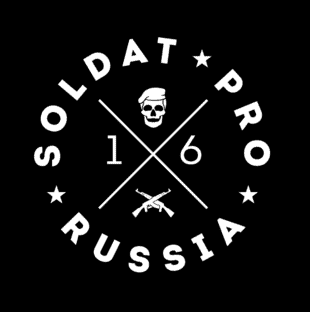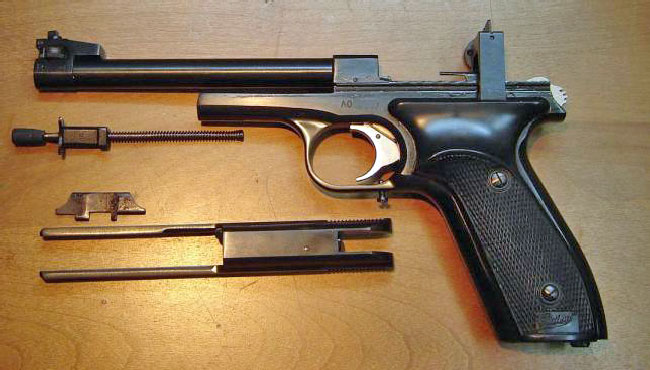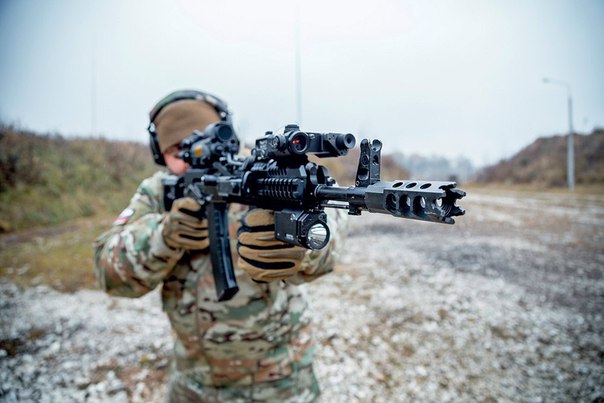
Since Kalashnikov invention was manufactured in the world more 70 million copies AK, as a licensed, and without it. This figure is 20% of the total number of all weapons on the planet. Needless to say, Kalash that good. But it can do even better.
Weapon tuning should not be confused with the car: at the heart of glamor is not put here, but the effectiveness of. The very word "tuning" gunsmiths understand quite literally: in English the tuning means tuning, adjustment.
In the army these improvements deemed unnecessary, but the arrow-athletes and special forces appreciate them for the possibility to adjust the weapon under its anatomical characteristics and special tasks, merge with it in a single unit. Russian and foreign manufacturers offer a variety of accessories for the most popular machine in the world.
Conventionally, they can be divided into three categories (It is indicated in the diagram in different colors): the first includes those, that makes the weapon more convenient, second - changing the characteristics of the shot, the third - to help the arrow hit right on target.
1. Anatomical fire control handle makes the grip more comfortable. Further recesses for the fingers and slip cover some handles are removable linings of different thickness, that help shooters with different sized hands to make weapons comfortable for themselves.
2. Front tactical handle offers a more comfortable grip, than usual for "forearm" or "sub shop", each of which has disadvantages. In the first case, the hand can slide along the forearm, so the arrow falls heavily compress it, which can cause overexertion of muscles and trembling arms. Grip "on a shop," reduces the frontal projection of the arrow, making it a difficult target for the enemy. But in this case to hold the weapon can only be bent arm, making it less rigid grip. Tactical handle solves these problems: placing it at an optimal distance from the shoulder, shooter can reliably hold the weapon without extra effort.
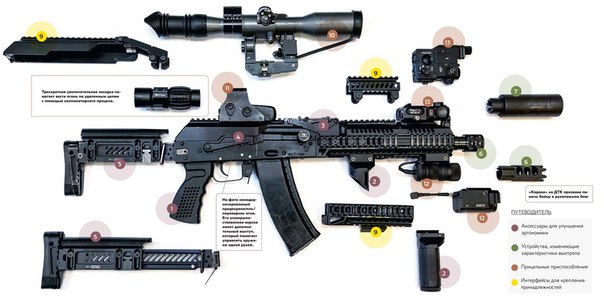
3. recharging handle in a normal embodiment is thin and smooth, when working hand in glove can come off with it. Remedy the situation will help the so-called "keg" - uhvatisty cylinder with non-slip notches.
4. Fuse / translator fire on the Kalashnikov machine does not allow all operations with one hand, holding the weapon, without removing it from the fire control handle. Improved translator / fuse has a second protrusion, resting on the index finger that can switch modes of fire or shoot guns off guard with one hand.
5. Telescopic buttstock with adjustable in length and height and provide the proper "tab" arrows with different length arms and neck. Some butts are equipped with height-adjustable "cheek", which is very important when shooting at long distances. "Cheek" may be a plastic or rubber. In addition to improving comfort in general good stuff helps prevent burn in summer or freezing in the cold.
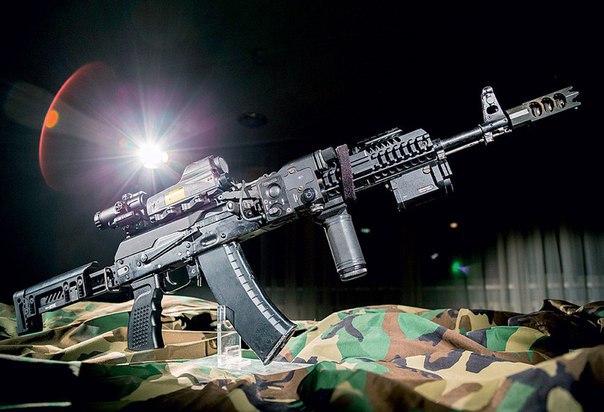
6. Muzzle brake-compensator (DTK) It is a small cylindrical nozzle, that has openings or slots on the housing. Exiting through the holes powder gases create a reactive force, offsetting the impact and toss the barrel when fired. Arrow less "shaking" and "pushes", and shooting is more accurate. DTC can be equipped with "crown", useful in hard detention of the offender. Lows in the DTK, that the machine rumbles with him, as a genuine gun! If people do not use special rifle headphones, they run the risk to get a decent contusion. Besides, the powder gases escape upwards and sideways powerful jet stream, and if the shooter working group, his neighbor can get a real push on the side or even burn. Another nuance - shooting lying: author personally observed, shooter with DTC has received a strong dose of sand in the face. That is why the DTC for the most part used only in sports.
7. Flash Hider, he's afterburner, dogoratel, maskirator, Unlike DTC, It has no holes in the side, but only the big bell in front. The device eliminates muzzle flash, helping to hide the location of the hand of the enemy and eliminate flare own night vision device. Also, the flame arrestor partially masks the sound of the shot, making it unclear: the enemy will be much harder to identify by ear, exactly where the shot was fired, although the sound he hears. The downside is that the flame arrester, that the return of weapons and toss it does not overwhelm, and may even slightly increase. The device is not very applicable in sports, but it is common in special units.
8. Silent fire weapon, aka silencer - a kind of flame arrester, which is used to eliminate the sound of a shot and the muzzle flash. By size is much greater than the flame arrestor and has only one opening in the front, of the same caliber, used as the munition. Extinguishes completely muzzle flash, sound is reduced to the level of the click, indistinguishable from a distance already 20 m. true, do not forget, that such a result would give PBS only with special subsonic ammo.
9. Picatinny rail (or more rare analog - Weaver) - a special system of rail fasteners for the installation of additional equipment and the adjustment of its position on weapons. Most sighting devices have standard attachment of the type. Rods are available as part of the removable side bracket, which is fastened to the guide of the "dovetail" on the left side Kalashnikov, or simply to equip a weapon parts with integrated Picatinny rail. Usually, we are talking about the forearm, handguard or lid of the receiver.
10. Riflescope increases the target image, so good for shooting at long distances, 200-300 m. It has a grid aiming to scale vertically amendments (the distance, temperature and air density) and horizontal (the wind, movement aims). Corrections can also be introduced via drums tactical, combining pre-Center reticle to the point of impact. "Optics" The downside is, that before aiming the shooter must build a completely straight line between the eye, monocular sight and reticle, otherwise it just will not see the picture.
11. Reflex Sight does not increase the goal, but the projects are not glass label, which denotes the place of bullet. The beauty of the collimator in the, there is no need to build a line of sight with him: even if the needle eye is not directly in front of the sight, he still sees the mark, which indicates the point hit. Scopes can be both daytime, and a day-night. Brightness label regulated under different lighting conditions. Collimator sight good for distances up to 100-200 m. To fire, you can use a special magnifying attachment for long distances, usually three times. In addition to magnifying the nozzle can also be installed night vision and thermal imaging.
12. Tactical lamp usually has a high capacity and light direction it directly into the eyes of the enemy can blind for a long time. Normally lights are made of waterproof and shockproof, to withstand vibration from the shooting and did not shut down, if the operative has to work in difficult climatic conditions. They may have several modes of brightness, including a Tom strobe mode, that is relevant, when the employee stormed the room and he needs to disorient criminal. Lights are both visible, and operating in the infrared spectrum and is found only in a night vision device.
13. laser pointer (LCU) It enables the laser beam, which denotes a place bullets hit directly with the target. distances, which can "beat" Laser Pointer, enormous. LCU, like lights, are visible and infrared. The latter give the label, invisible to the observer, not armed PNV. spetsnaz group can completely unnoticed closer to the enemy and destroy it aimed fire, Using night vision goggles and infrared laser designators. In this case, the enemy does not know, that he had long been in the crosshairs. LCC may be combined with conventional infrared lamps and, embedded in the collimator sights.







